|

|
| Horseshoe Bend Anchorage, St. Mary's |
Friday, July 20, 2007
Solomons to St. Mary's City
42.2 miles
We left the Potomac and traveled eight miles up the St. Mary's River to get to St. Mary's City. Despite its name,
there is no city here, and there hasn't been one for about 300 years.
Back in the 1600s, though, St. Mary's was a bustling metropolis. Established in 1634, it was the fourth permanent English
settlement in North America, Maryland's first capitol, and a haven of religious tolerance for Catholics (Lord Baltimore, whose
family heraldic crest graces the Maryland state flag and seal, was Roman Catholic).
The Colonists finished their State House here in 1676, but it wasn't used long -- the Protestant majority in
Maryland objected to having their capitol in a Catholic city, and moved it to Annapolis in 1695. So much for religious
freedom, and for separation of church and state. And, so much for St. Mary's -- the town was abandoned and forgotten
for 300 years.
At Maryland's tercentennial, a couple monuments were installed, reminding folks of the historical import of St. Mary's,
and about thirty years later, a commission was formed to develop the site in a way that would help preserve the site and the
story of Maryland's founding.
Today, an 800 acre archeaological site and recreation of Historic St. Mary's City, complete with interpreters in period
attire, stands on the site of the ghost town, high on a bluff with commanding views of the wide St. Mary's River.
An obeslisk in a church cemetery marks the spot where Governor Calvert met with Indians under a mulberry tree to negotiate
the purchase of the land now known as St. Mary's City, and other markers in the cemetery trace the outline of the foundation
of the original State House (a replica stands nearby, next to the church).
The major population center of St. Mary's today is St. Mary's College, a small public liberal arts honors college with
buildings dating back to 1839, when it was a finishing school for young ladies. This is the only college we have ever
seen with no college town -- no bars, no fast food restaurants or pizza joints, nowhere to go off campus if you don't have
a car. This is somewhat ironic, since when St. Mary's was in its heyday in the 1600s, the place was loaded with places to
eat and drink and carrouse, to serve all the people visiting to do government business, so the recreated fake town has several
such establishments for demonstration purposes only, while the real St. Mary's of today has none, unless you count the Campus
Center and the Cafeteria.
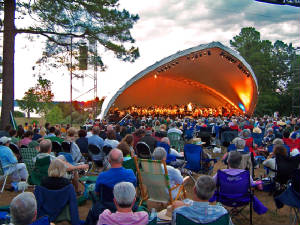
Every Friday night in June and July, 3000-4000 people gather for a college sponsored concert series held on the
Cote de Crabe, a large lawn on campus overlooking the river. There they picnic and listen to the Chesapeake Symphony
Orchestra perform great music as the sun goes down.
We dinghied in with our lawn chairs, and selected our dinners from the vast array of food booths. But, other concert-goers
came with more elaborate picnics -- tables with cloths and flowers, expensive champagne cooling in a silver bucket, vintage
picnic baskets, expansive fruit and cheese trays. Just ogling the audience provided plenty of entertainment before the
concert began.
The featured soloist -- James Gourlay -- was a tuba impressario from Scotland. He performed a Ralph Vaughan Williams
Concerto for Tuba with the orchestra that was exquisite. It shattered all our notions of the musicality of the tuba.
The rest of the concert was wonderful, too (although we would have liked to listen to James Gourlay play tuba all night,
instead). We watched the sun set with crimson drama behind the band shell during Tchaikovsky's Symphony 4, which may
not be as good as watching fireworks during his 1812 Overture, but it is close.
Saturday, July 21, 2007
St. Mary's, MD to Colonial Beach, VA
39 miles
We dinghied to shore to begin the day with breakfast at the St. Mary's College Cafeteria. We paid $3.20 apiece
for a belly busting array of breakfast choices -- made to order eggs and omelettes; all sorts of breakfast meats, including
my favorite, creamed chipped beef; multiple potato options; bisquits and breads and sweet rolls; fresh fruit; yogurt,
cereal . . . lots of juices and coffee. We have never seen a better breakfast deal in all our travels (and we have traveled
far and wide seeking breakfast).
The dining area of the cafeteria is also exceptional -- it has a high vaulted ceiling with the wood rafters and
cross-ties exposed, the walls are stained wood and big glass window panels, and the floor is polished black slate.
All the tables and chairs are cherry wood in a simple Shaker style. Breakfast here was simply elegant.
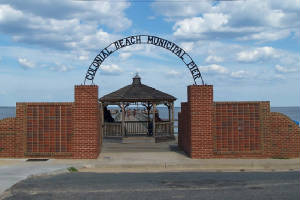
|
| Colonial Beach Pier |
Thus fortified, we raised anchor at 9:40 and were one our way upriver to Colonial Beach, Virginia.
Colonial Beach's rich oyster beds attracted Indians and colonial settlers to its shores. Since colonial times, artificial
reefs created by discarded oyster shells have created a hazard to navigation, threatening to ground unwary ships.
In the 1800s, bloody feuds known as "Oyster Wars" were fought over the rights to harvest the bountiful oyster beds. Oysters
were so plentiful that the owners of indentured servants and slaves were tempted to provide them as the exclusive diet for
their laborers. In response, laws were passed requiring the owners to feed their laborers something other than
oysters at least twice weekly. (Imagine the workers' reaction to enactment of that compassionate legislation -- now they
could look forward to just five days of week of oysters for breakfast, lunch and dinner!)
We took the 25 cent hour long trolley tour about Colonial Beach, and decided we had seen enough to know we didn't need
to bring our bikes off the boat to explore further.
Around the turn of the twentieth century a series of developers acquired the land where the town lies, with a vision
of develping it as a waterfront community. They began with naming the new town Colonial Beach. Evading laws against
gambling in Virginia, they built gambling venues on piers over the Potomac, which is owned by Maryland, where gambling is
legal. Even today, the town's big casino is located over the Potomac.
The beach is pebbly, and the charming little places in town are so spread out among the run-down and vacant and seedy
places that they lose critical mass. This is a place that could benefit from a little zoning.
The most distinctive aspect of Colonial Beach is that the whole town is a golf cart community -- locals drive colorful
and sometimes whimsical golf carts on the public streets, and road signs with Amish carriage symbols on them warn motorists
to watch for slow vehicles. (We never saw an Amish person or carriage, so we can only assume the signs refer to the
golf carts, which are plentiful.)
In tribute to the rich oystering heritage of Colonial Beach, we ate a white tablecloth dinner at the marina's restaurant,
which is located in an oyster house built in 1932. Back then, the lower floor of the oyster house was used to shuck
and pack oysters, while the second story provided housing for the oyster shuckers. The house floated away in a flood
in 1933, but mules hauled it back, and the owner anchored it more firmly on this spot, where it has remained since then.
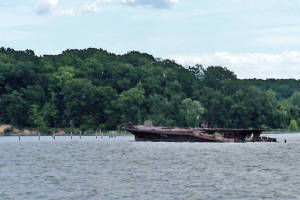
|
| Mallows Bay ship graveyard |
Sunday, July 22, 2007
Colonial Beach, VA to Smallwoood State Park, MD (on Mattawoman Creek)
46 miles
Our cruise today took us past the watery grave of 200 ships that were sunk in the hope that their history of bureaucratic
blundering would be buried with them. We uncovered the story in a cruise guide, and add it to our ever increasing file
of hidden American history revealed during our travels. Here's the sorry tale:
When the US entered World War I, our shipyards were working overtime constructing steel ships. The US decided
we could use semi-skilled labor to quickly and cheaply build a fleet of wooden steamers to supplement the steel ships
damaged in the war. They figured they could build 1,000 wooden ships in 18 months.
When it took 8 months just to place the contracts for the first 300 vessels, they should have realized their plan was
flawed. A month later, they discovered the wrong lumber had been purchased for the keels and hulls, and the correct
wood was only available from West Coast contractors. The bureaucrats barreled on, initiating a parallel wooden ship
construction program on the West Coast. Infighting between the two programs was rampant, as anyone could have predicted.
The Navy refused to man the vessels, doubting their seaworthiness. Design changes and delays followed.
When Germany surrendered, about 18 months after the program began, just 134 ships had been completed, and none of them
had been deployed to Europe as planned. The ships leaked and could not carry enough cargo to justify their operating
expense, but, inexplicably, the government still kept building more wooden freighters.
After the war, most of the wooden ships were anchored with the ghost fleet on the James River (which we saw and wrote
about on June 21). They weren't there long before it became clear that the wooden ships were useless and a challenge to keep
afloat, so they were sold for scrap. All told, about 200 of them were towed down the James and up the Potomac to Alexandria
to be stripped of machinery and equipment, then towed down the Potomac to their final resting place at Mallows Bay, where
they were burned to the waterline and salvaged for metal.
The story doesn't end here -- in the 1930s the ships were searched once more to recover any remaining scrap metal, which
was sold to Japan, who returned that metal to us in the form of shells and other weaponry during World War II.

|
| Smallwood's Retreat |
We had our own little series of misadventures afloat today. Our original cruising plan called for us to anchor
out in Matawoman Creek and dinghy in to Smallwood State Park, where we would visit Smallwood's Retreat, home of Revolutionary
War hero General William Smallwood. Smallwood's Retreat is only open for tours on Sunday afternoons, and we timed our
visit to arrive on Sunday afternoon.
Our first problem was that our dinghy sprung a leak yesterday, so dinghying in was not an option. The second problem
was that Matawoman Creek was so overgrown with weeds that our depth sounders could not give us a reliable reading, making
anchoring near enough to the park dock to kayak in impossible.
Thinking we might be able to tie up at the park dock, tour the house, then motor back out to a suitable anchorage, we
radioed the park marina, where a very pleasant but not very knowledgeable employee told us she thought the water at the dock
was deep enough for us to approach. Lacking confidence, but somewhat desperate, we felt our way in through the entrance
channel and fought the wind to dock ourselves, while the marina employee sat in an Adirondack chair on the front porch of
the marina and watched us. She, her companion on the porch, and a couple fishermen complimented us on our docking skills
under the challenging conditions. We wished they had decided to get up for a closer look while we were endeavoring to
secure ourselves.
After learning about the cheap dockage rates, and considering the windy conditions, we ended up deciding to just
get a slip in the marina. There were abundant weeds floating near the dock where the marina employee said she put all
the transients, and we feared that our engine intakes would get clogged with them, or that we might go aground, since the
weeds would render our depth finders useless. Dick begged to be allowed to use the "special slip" she gave a deep
draft sailboat who visited regularly, but wasn't expected today. Dick charmed her, and she relented to allow us to use
the special space.
After all that effort, when we finally hiked up to Smallwood's Retreat, it was locked up tight, with no ranger or curator
in sight. You would think that when the park only opens the place for four hours a week, they ought to be able to keep
it staffed.
We did get a nice walk through woods and fields, a geocache find, a ten minute visit to Mattawoman Creek Art Center's
exhibit of the work of local artists and artisans, and a couple ice cream bars out of our stop in the park.
But, we were left wondering who administers this place, and does it bother them that the marina, built in 1990, is falling
into disrepair, the campground only has two sites in use on a summer weekend, and the main historic attraction is unstaffed
during advertised hours? It bothers us.
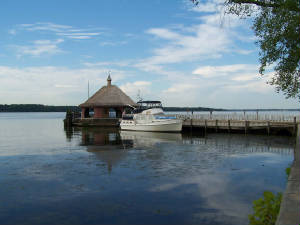
|
| Starsong at Mount Vernon's wharf |
Monday, July 23, 2007
Caught in a Snowstorm on the Way to DC
31.2 miles
We got an early start, because we planned to stop at Mount Vernon on our way to DC today, and without a dinghy, our ability
to visit was dependent on snagging a spot on the dock. This time, all went according to plan, and the dock was empty
at 9:30 when we got to Mount Vernon.
When George Washington inherited Mount Vernon from his half brother, it came with 2,000 acres of land. George made
many improvements and additions to the house, and eventually built its landholdings to encompass 8,000 acres, including five
farms, a fishery, and a distillery.
His heirs didn't have much business sense, it seems -- by 1853 the house was a wreck, with old ship masts holding up
the sagging back verandah roof. Amazingly, neither the state nor the federal government wanted anything to do with Mount
Vernon. Scandalized by the state of our founding father's estate, Ann Pamela Cunningham of South Carolina founded the
Mount Vernon Ladies' Association to purchase and preserve George Washington's home and tomb, and they acquired the house from
John A. Washington, Jr. in 1858. Today, nearly 150 years later, the Ladies' Association still owns and administers the
house and 800 acres of grounds around it. Using inventories made after Washington died, they have meticulously
renovated and furnished the house with original and period furnishings, renovated its outbuildings and recreated the
gardens. Beyond that, they have built an impressive education center and museum out of the sightlines of the house,
and have purchased land across the Potomac from the house to preserve the wooded view as it would have looked in 1799, the
year of Washington's death. The scope of their work is astounding.
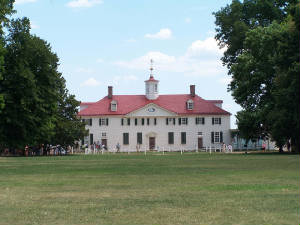
We walked up a steep trail from the waterfront wharf to the bluff on which Mount Vernon sits in stately splendor.
It felt like we walked the full 800 acres of the estate to get from our boat to the entry point where tickets are sold, and
it was a beautiful walk. Armed with audio tour players and maps, we made our way to the house, where the staff efficiently
led groups of 25 through rooms painted in astonishingly gaudy colors chosen by George Washington. According to
our guide, it was the fashion back then for the man of the house to choose the colors and decor, so we can only conclude that
George Washington was partial to a cool palette -- he chose shades of deep turquoise, bright Irish shamrock green, and
a 1960s eyeshadow blue for the main entertaining rooms on the first floor.
Martha chose the decor for their bedroom. It was creamy white with very pale blue trim, a relaxing respite
from the loud colors of the public spaces and guest rooms. From this we might conclude that Martha and George had very
different aesthetic tastes. Since George spent a lot of time away from home pursuing his military and political
missions, I wonder if Martha ever had the urge to surprise him with a decorating make-over, or if she liked living with
his colors as a reminder of him while he was away.
After we toured the house, we used our audio guides to tour the many outbuildings on the grounds. We visited George
and Martha's tomb, where their stone sarcophogi are visible to visitors during the day, and protected by a heavy door and
three padlocked metal gates at night.
The estate has farm animals, which we skipped, vegetable gardens, an orchard, and a beautiful walled flower garden beside
a brick greenhouse.
Our next stop was the education center and museum. The education center has a bunch of theatres
with multi-media presentations of significant episodes in our nation's history where George Washington played a starring
role. We watched several, but the most memorable one had to be the presentation about Washington leading the troups
in the Revolutionary War battle where they crossed the Delaware. Unfortunately, I can't remember the name of the battle,
because I was overwhelmed by the memorable special effects -- our chairs shook and violent orange strobe lights flashed as
the battle was waged, and real snow actually fell on us, right along with Washington and his men, as they crossed
the Delaware on Christmas Day whatever year it was.
We were also impressed with Washington's false teeth on display in the Education Center. They were made of a motley
array of dingy yellow and brown human and animal teeth set in grey lead gum plates. I am not sure why anyone would find
them to be more attractive than bare gums. Perhaps he only wore them as an aid to eating, rather than as a cosmetic
accessory.
By now the afternoon was wearing on, and we were getting concerned about arriving in DC before the Capital Yacht Club
staff went home for the night. So, we made one of our fastest tours through a museum ever, using our audio guides to
lead the way to only the highlights in each of the seven artifact-filled galleries.
We turned in our audio guides, grabbed a quick late lunch of ice cream at the food court, and hiked back to the boat,
agreeing that we had seen enough of Mount Vernon to do it justice, but that we could have stayed until closing time, and still
not seen everything that interested us here.
And, yes, we made it to Washington DC before the Yacht Club staff went home. We can see the Washington Monument
looming above the bow of our boat. We are looking forward to a week of grand adventures in our nation's capital -- enjoying
our tax dollars at work.
Click here to continue to Washington, DC.
|

